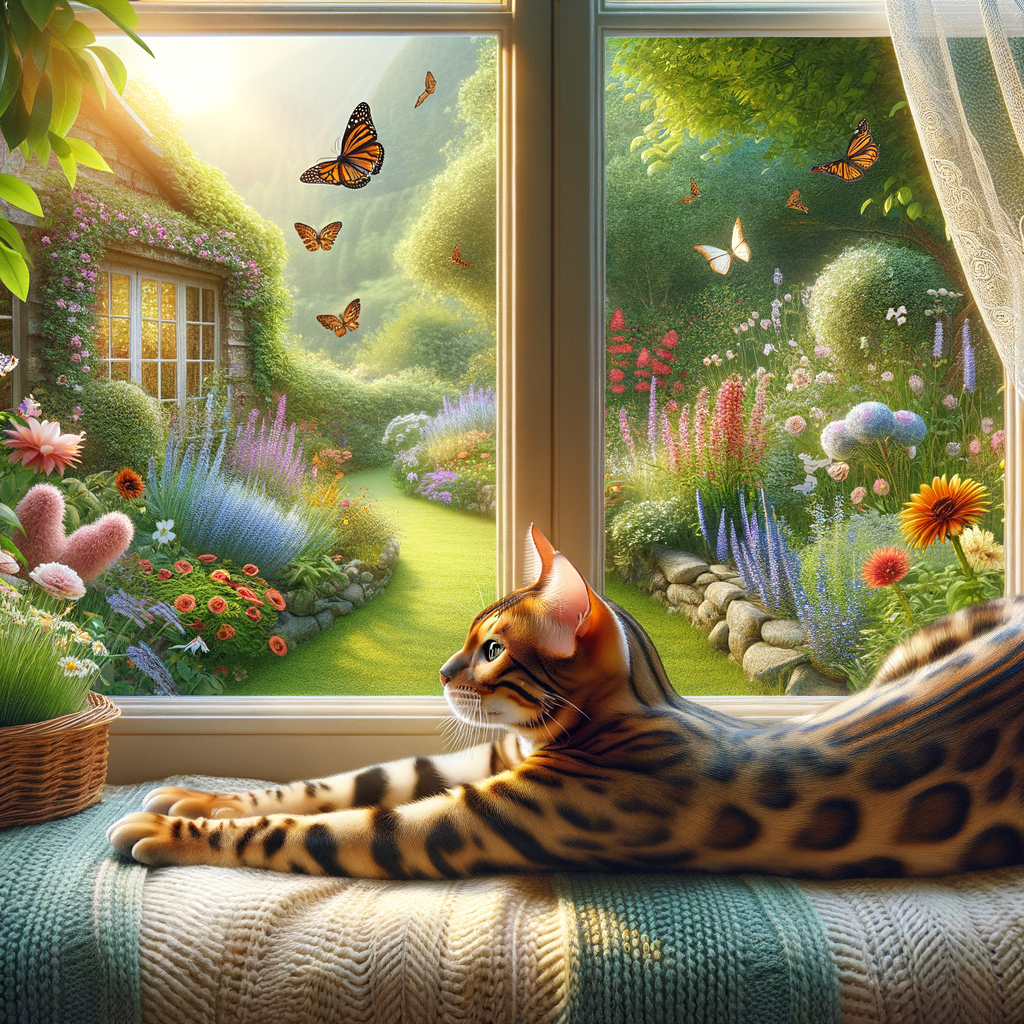
The Lifespan of a Bengal Cat: An Overview
-
Introduction to Bengal Cat Lifespan
Bengal cats are known for their beautiful, leopard-like spots and playful nature. But how long do these unique cats live? Understanding their lifespan can help you provide the best care for your Bengal cat.
-
Average Lifespan of a Bengal Cat
On average, Bengal cats live between 12 to 16 years. This lifespan can vary based on factors like genetics, diet, and overall care. Some Bengals have been known to live even longer with proper care.
-
Bengal Cat Lifespan Comparison with Other Breeds
When compared to other cat breeds, Bengal cats have a relatively long lifespan. For example, the average lifespan of a domestic shorthair cat is around 12 to 14 years. Siamese cats, another popular breed, often live between 15 to 20 years.
Cat Breed Average Lifespan Bengal 12-16 years Domestic Shorthair 12-14 years Siamese 15-20 years
Factors Affecting Bengal Cat Lifespan
Genetics and Bengal Cat Lifespan
- Role of genetics in Bengal cat longevity: Just like humans, the genes inherited from their parents can influence how long they live. Healthy genes can lead to a longer life, while problematic genes can cause health issues.
- Common genetic issues in Bengal cats: Bengal cats can inherit certain genetic problems. Some of these issues include heart disease and hip dysplasia. These conditions can affect their quality of life and lifespan. Regular vet check-ups can help catch these problems early.
Diet and Bengal Cat Lifespan
-
Importance of a Balanced Diet
It helps them stay healthy and live longer. Proper nutrition supports their immune system, keeps their coat shiny, and maintains their energy levels.
Feeding your Bengal cat the right food can prevent common health issues. For example, a diet rich in protein helps build strong muscles. Vitamins and minerals are also essential for overall health.
-
Recommended Diet for Bengal Cats
Bengal cats need a diet high in protein. They are active and playful, so they burn a lot of energy. Here are some key points for their diet:
- Protein: Choose foods with high-quality meat like chicken, turkey, or fish.
- Fats: Healthy fats are important for their coat and skin. Look for foods with fish oil or chicken fat.
- Carbohydrates: While not essential, small amounts of carbs can provide energy. Avoid grains and opt for vegetables instead.
- Vitamins and Minerals: Ensure the food has essential vitamins like A, D, and E, and minerals like calcium and phosphorus.
Here is a simple table to summarize the recommended diet:
Nutrient Source Protein Chicken, Turkey, Fish Fats Fish Oil, Chicken Fat Carbohydrates Vegetables Vitamins and Minerals Vitamin A, D, E, Calcium, Phosphorus Feeding your Bengal cat the right diet can make a big difference in their lifespan. Always consult your vet for personalized advice.
Environment and Bengal Cat Lifespan
- Impact of indoor vs outdoor living:
The environment where a Bengal cat lives can greatly affect its lifespan. Indoor cats generally live longer than outdoor cats. This is because indoor cats are less exposed to dangers like traffic, predators, and diseases. According to a study, indoor cats can live up to 15 years or more, while outdoor cats have an average lifespan of 5 years. - Importance of a stimulating environment:
Bengal cats are active and curious. They need a stimulating environment to stay happy and healthy. Providing toys, climbing trees, and interactive play can keep them engaged. A bored Bengal cat can develop behavioral problems and stress, which can affect its health and lifespan. Ensuring a stimulating environment can help your Bengal cat live a longer, healthier life.
Bengal Cat Health and Lifespan
Common Health Issues in Bengal Cats
- Overview of common health issuesBengal cats are generally healthy, but they can face certain health problems. Some common issues include:
- Hypertrophic Cardiomyopathy (HCM): This is a heart disease that thickens the heart muscles.
- Progressive Retinal Atrophy (PRA): This eye disease can lead to blindness.
- Feline Infectious Peritonitis (FIP): This is a viral disease that affects the abdomen and chest.
- Hip Dysplasia: This is a genetic condition that affects the hip joints.
- How these issues can affect lifespanHealth problems can shorten a Bengal cat’s lifespan if not treated properly. For example:
- HCM: Can lead to heart failure if not managed.
- PRA: While not life-threatening, it can reduce the quality of life.
- FIP: Often fatal, especially in young cats.
- Hip Dysplasia: Can cause pain and mobility issues, affecting overall well-being.
Regular vet check-ups and early detection can help manage these issues, potentially extending your Bengal cat’s life.
Preventive Healthcare for Bengal Cats
- Regular veterinary check-ups:
These check-ups help catch any health problems early. The vet can check your cat’s weight, teeth, and overall health. It’s best to visit the vet at least once a year. Regular check-ups can help your Bengal cat live a longer, healthier life. - Vaccinations and their role in longevity:
Vaccinations protect your Bengal cat from many diseases. These shots help their immune system fight off illnesses. Common vaccines include those for rabies, feline distemper, and feline leukemia. Keeping up with vaccinations can add years to your Bengal cat’s life.
Extending Bengal Cat Lifespan: Practical Tips
Ensuring your Bengal cat lives a long and healthy life involves several key practices. Here are some practical tips to help extend your Bengal cat’s lifespan:
- Proper NutritionChoose high-quality cat food that meets their nutritional needs. Avoid giving them too many treats or human food. Fresh water should always be available.
- Regular ExerciseBengal cats are very active and need regular exercise to stay healthy. Provide toys and playtime to keep them moving. Interactive toys and climbing structures can help keep them fit and happy.
- Mental StimulationKeeping your Bengal cat mentally stimulated is just as important as physical exercise. Puzzle toys, training sessions, and new experiences can keep their minds sharp. Rotate toys to keep things interesting.
- Preventive HealthcareRegular vet check-ups are essential. Vaccinations, dental care, and parasite prevention can help avoid serious health issues. Early detection of problems can lead to better outcomes.
By following these tips, you can help ensure your Bengal cat enjoys a long, healthy, and happy life.
Case Study: Longest Living Bengal Cat
- Overview of the cat’s lifeThe longest living Bengal cat on record lived to be 25 years old. This cat, named “Whiskers,” was born in 1995 and lived a vibrant and active life until 2020. Whiskers was known for his playful nature and strong bond with his family. He enjoyed chasing toys, climbing trees, and lounging in sunny spots.
- Factors contributing to its long lifespanSeveral factors contributed to Whiskers’ long life:
- Diet: Whiskers was fed a balanced diet rich in protein and essential nutrients.
- Regular Vet Visits: He had regular check-ups with the vet, which helped catch and treat any health issues early.
- Exercise: Whiskers had plenty of opportunities for physical activity, which kept him fit and healthy.
- Love and Care: He received lots of love and attention from his family, which contributed to his overall well-being.
How Long Do Bengal Cats Live?
Bengal cats are known for their beauty and playful nature. But how long do they live? Let’s recap what we’ve learned about their life expectancy.
- Recap of Bengal cat life expectancy: Bengal cats typically live between 12 to 16 years. With proper care, some can even live longer.
- Key takeaways for Bengal cat owners:
- Provide a balanced diet to keep them healthy.
- Regular vet check-ups are essential.
- Ensure they get plenty of exercise and mental stimulation.
- Keep their living environment clean and safe.
| Key Factors | Impact on Lifespan |
|---|---|
| Diet | Proper nutrition can extend lifespan. |
| Exercise | Regular activity keeps them fit and healthy. |
| Vet Visits | Early detection of health issues can save lives. |
| Environment | A safe and clean home reduces risks. |






